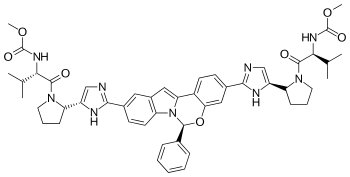Elbasvir
Elbasvir is a drug approved by the FDA in January 2016[1] for the treatment of hepatitis C. It was developed by Merck and completed Phase III trials, used in combination with the NS3/4A protease inhibitor grazoprevir under the trade name Zepatier, either with or without ribavirin.[2]
 | |
| Clinical data | |
|---|---|
| Trade names | Zepatier (combination with grazoprevir) |
| Other names | MK-8742 |
| License data | |
| Routes of administration | Oral |
| ATC code | |
| Legal status | |
| Legal status |
|
| Pharmacokinetic data | |
| Protein binding | >99.9% |
| Metabolism | CYP3A4 |
| Elimination half-life | 24 hours |
| Excretion | >90% via faeces, <1% via urine |
| Identifiers | |
IUPAC name
| |
| CAS Number | |
| PubChem CID | |
| DrugBank | |
| ChemSpider | |
| UNII | |
| KEGG | |
| ChEBI | |
| ECHA InfoCard | 100.234.242 |
| Chemical and physical data | |
| Formula | C49H55N9O7 |
| Molar mass | 882.015 g/mol g·mol−1 |
| 3D model (JSmol) | |
SMILES
| |
InChI
| |
Elbasvir is a highly potent and selective NS5A inhibitor of the hepatitis C virus NS5A replication complex.[3] It has only been investigated as a combination product with other complementary hepatitis C antiviral drugs such as grazoprevir and MK-3682, and it is unclear whether elbasvir would show robust antiviral activity if it was administered by itself. Nevertheless, combination products of this type represent the most successful approach yet developed for actually curing hepatitis C, rather than merely slowing the progression of the disease.[4]
Side effects
Side effects have only be assessed in the combination with grazoprevir; see Elbasvir/grazoprevir#Side effects.
Interactions
Elbasvir is degraded by the liver enzyme CYP3A4. Combination with drugs that induce this enzyme, such as efavirenz, carbamazepine or St. John's wort, can lead to ineffectively low plasma levels of elbasvir. Combination with CYP3A4 inhibitors may increase plasma levels.[5]
Pharmacology
Mechanism of action
The substance blocks NS5A, a protein necessary for hepatitis C virus replication and assembly.[5]
Pharmacokinetics
Elbasvir reaches peak plasma concentrations three hours after oral intake together with grazoprevir (variation between patients: three to six hours). In hepatitis C patients, steady state concentrations are found after about six days. Plasma protein binding is over 99.9%, mainly to albumin and alpha-1-acid glycoprotein. Part of the substance is oxidised in the liver, largely by the enzyme CYP3A4. The biological half-life is 24 hours on average. Over 90% are excreted via the faeces, and less than 1% via the urine.[5][6]
References
- FDA approves Zepatier for treatment of chronic hepatitis C genotypes 1 and 4. January 28, 2016
- Lawitz, E; Gane, E; Pearlman, B; Tam, E; Ghesquiere, W; Guyader, D; Alric, L; Bronowicki, JP; Lester, L; Sievert, W; Ghalib, R; Balart, L; Sund, F; Lagging, M; Dutko, F; Shaughnessy, M; Hwang, P; Howe, AY; Wahl, J; Robertson, M; Barr, E; Haber, B (2015). "Efficacy and safety of 12 weeks versus 18 weeks of treatment with grazoprevir (MK-5172) and elbasvir (MK-8742) with or without ribavirin for hepatitis C virus genotype 1 infection in previously untreated patients with cirrhosis and patients with previous null response with or without cirrhosis (C-WORTHY): a randomised, open-label phase 2 trial". Lancet. 385 (9973): 1075–86. doi:10.1016/S0140-6736(14)61795-5. PMID 25467591.
- Coburn, CA; Meinke, PT; Chang, W; Fandozzi, CM; Graham, DJ; Hu, B; Huang, Q; Kargman, S; Kozlowski, J; Liu, R; McCauley, JA; Nomeir, AA; Soll, RM; Vacca, JP; Wang, D; Wu, H; Zhong, B; Olsen, DB; Ludmerer, SW (2013). "Discovery of MK-8742: an HCV NS5A inhibitor with broad genotype activity". ChemMedChem. 8 (12): 1930–40. doi:10.1002/cmdc.201300343. PMID 24127258.
- Gentile, I; Buonomo, AR; Zappulo, E; Borgia, G (Jul 2014). "Interferon-free therapies for chronic hepatitis C: toward a hepatitis C virus-free world?". Expert Review of Anti-Infective Therapy. 12 (7): 763–73. doi:10.1586/14787210.2014.929497. PMID 24918116.
- Haberfeld, H, ed. (2016). Austria-Codex (in German). Vienna: Österreichischer Apothekerverlag.
- FDA Professional Drug Information on Zepatier.